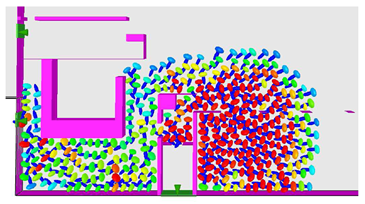The Problem of Predicting Crowd Crush
Crowd control is a significant problem for organisers of major public events. Last month, 19 people died in a crush at a dance music event called the Love Parade in Germany when a crowd was channelled through a tunnel. In 2005, 350 died in a stampede during the annual pilgrimage to Mecca, while 250 died in a similar disaster the year before.

So the ability to spot the conditions that could lead to crowd crush in real time would be a significant breakthrough. Today, Peter Harding from Manchester Metropolitan University in the UK and pals say they think they know how it can be done.
One way to determine the forces in a crowd is to calculate them using the position and velocity of every individual. But this task is computationally demanding and cannot yet be done in real time or anywhere near it. The algorithms are so slow that they are of limited use, even for crowd control planning.
What’s needed is some other property of the crowd that is easier to calculate but can be directly correlated with the forces. Harding and co say they have found such a proxy. Their idea is based on the observation that in ordinary circumstances the behaviour of individuals in a crowd is ordered. However, this behaviour seems to undergo a phase transition to a more disordered state when crowd crush develops.
This suggests that a simple measure of crowd order and the way it is changing ought to give some idea of the way crowd crush is developing. And that a good understanding of these changes could provide an early warning of a potential crowd crush, like a weather forecast.
It turns out that order and disorder is easily measured by examining the position of the individuals in a crowd and their heading. If these quantities are highly correlated, the crowd is ordered. If it is not, the individuals are wandering around at random. The measure of this correlation is called mutual information and it is simple enough to calculate in real time.
Harding and co’s idea is that a change in mutual information–ie a change from ordered to disordered crowd behaviour–is a good proxy for the crush forces that individuals in the crowd must be experiencing.
The team has tested this idea using a simulation of the 2003 Station Nightclub disaster in which 96 people died, many of them from crush injuries, after fire broke out in a nightclub in Rhode island.
This disaster has been well studied and the crowd behaviour simulated using data from sources such as security camera footage and the testimony of survivors about their exit strategies. It is therefore possible to calculate, using the conventional computationally intensive methods, the crush forces that must have developed in the crowd.
However, Harding and co have also calculated the correlation between the position and heading of the individuals in the crowd and say there is a good correlation to be found.
That raises the possibility that an algorithm that calculated this correlation from live footage of a crowd could give an indication of the forces at work.
Whether this measure would turn out to be useful is another matter entirely. What’s at issue is whether there is a unique correspondence between Harding’s chosen correlation and dangerous forces or whether harmless patterns of crowd behaviour could produce correlations that look as if dangerous forces are developing. In other words, what’s the rate of false positives?
That’s not a question that Harding and co address here. So it’s a stretch to imagine that this method could work as an early warning sign for crowd control, as suggested by the title of their paper but barely mentioned within it. That kind of forecast would clearly need a much deeper and more complete understanding of what is going on.
Ref: arxiv.org/abs/1008.2160: An Early Warning Method For Crush
Keep Reading
Most Popular
Large language models can do jaw-dropping things. But nobody knows exactly why.
And that's a problem. Figuring it out is one of the biggest scientific puzzles of our time and a crucial step towards controlling more powerful future models.
The problem with plug-in hybrids? Their drivers.
Plug-in hybrids are often sold as a transition to EVs, but new data from Europe shows we’re still underestimating the emissions they produce.
Google DeepMind’s new generative model makes Super Mario–like games from scratch
Genie learns how to control games by watching hours and hours of video. It could help train next-gen robots too.
How scientists traced a mysterious covid case back to six toilets
When wastewater surveillance turns into a hunt for a single infected individual, the ethics get tricky.
Stay connected
Get the latest updates from
MIT Technology Review
Discover special offers, top stories, upcoming events, and more.